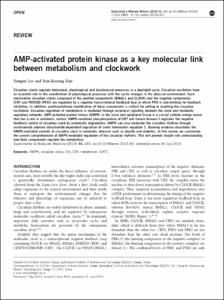Department of Brain Sciences
Lab of Neuro-Metabolism & Neurometabolomic Research Center
1. Journal Articles
Full metadata record
| DC Field | Value | Language |
|---|---|---|
| dc.contributor.author | Lee, Yongjin | - |
| dc.contributor.author | Kim, Eun-Kyoung | - |
| dc.date.available | 2017-07-11T06:34:58Z | - |
| dc.date.created | 2017-04-10 | - |
| dc.date.issued | 2013-07 | - |
| dc.identifier.issn | 1226-3613 | - |
| dc.identifier.uri | http://hdl.handle.net/20.500.11750/3225 | - |
| dc.description.abstract | Circadian clocks regulate behavioral, physiological and biochemical processes in a day/night cycle. Circadian oscillators have an essential role in the coordination of physiological processes with the cyclic changes in the physical environment. Such mammalian circadian clocks composed of the positive components (BMAL1 and CLOCK) and the negative components (CRY and PERIOD (PER)) are regulated by a negative transcriptional feedback loop in which PER is rate-limiting for feedback inhibition. In addition, posttranslational modification of these components is critical for setting or resetting the circadian oscillation. Circadian regulation of metabolism is mediated through reciprocal signaling between the clock and metabolic regulatory networks. AMP-activated protein kinase (AMPK) in the brain and peripheral tissue is a crucial cellular energy sensor that has a role in metabolic control. AMPK-mediated phosphorylation of CRY and Casein kinases I regulates the negative feedback control of circadian clock by proteolytic degradation. AMPK can also modulate the circadian rhythms through nicotinamide adenine dinucleotide- dependent regulation of silent information regulator 1. Growing evidence elucidates the AMPK-mediated controls of circadian clock in metabolic diseases such as obesity and diabetes. In this review, we summarize the current comprehension of AMPK-mediated regulation of the circadian rhythms. This will provide insight into understanding how their components regulate the metabolism. © 2013 KSBMB. | - |
| dc.language | English | - |
| dc.publisher | Nature Publishing Group | - |
| dc.title | AMP-activated protein kinase as a key molecular link between metabolism and clockwork | - |
| dc.type | Article | - |
| dc.identifier.doi | 10.1038/emm.2013.65 | - |
| dc.identifier.scopusid | 2-s2.0-84882966981 | - |
| dc.identifier.bibliographicCitation | Experimental and Molecular Medicine, v.45, no.7, pp.1 - 7 | - |
| dc.identifier.kciid | ART001790595 | - |
| dc.description.isOpenAccess | TRUE | - |
| dc.subject.keywordAuthor | AMPK | - |
| dc.subject.keywordAuthor | circadian clock | - |
| dc.subject.keywordAuthor | CKI | - |
| dc.subject.keywordAuthor | CRY | - |
| dc.subject.keywordAuthor | metabolism | - |
| dc.subject.keywordAuthor | SIRT1 | - |
| dc.subject.keywordPlus | PERIPHERAL CLOCK | - |
| dc.subject.keywordPlus | PERIOD PROTEINS | - |
| dc.subject.keywordPlus | SKELETAL-MUSCLE | - |
| dc.subject.keywordPlus | EPSILON CKI-EPSILON | - |
| dc.subject.keywordPlus | CIRCADIAN CLOCK | - |
| dc.subject.keywordPlus | I-EPSILON | - |
| dc.subject.keywordPlus | GENE-EXPRESSION | - |
| dc.subject.keywordPlus | FOOD-INTAKE | - |
| dc.subject.keywordPlus | DOUBLE-TIME | - |
| dc.subject.keywordPlus | SUPRACHIASMATIC NUCLEUS | - |
| dc.citation.endPage | 7 | - |
| dc.citation.number | 7 | - |
| dc.citation.startPage | 1 | - |
| dc.citation.title | Experimental and Molecular Medicine | - |
| dc.citation.volume | 45 | - |
- Files in This Item:
-
 기타 데이터 / 622.89 kB / Adobe PDF
download
기타 데이터 / 622.89 kB / Adobe PDF
download



